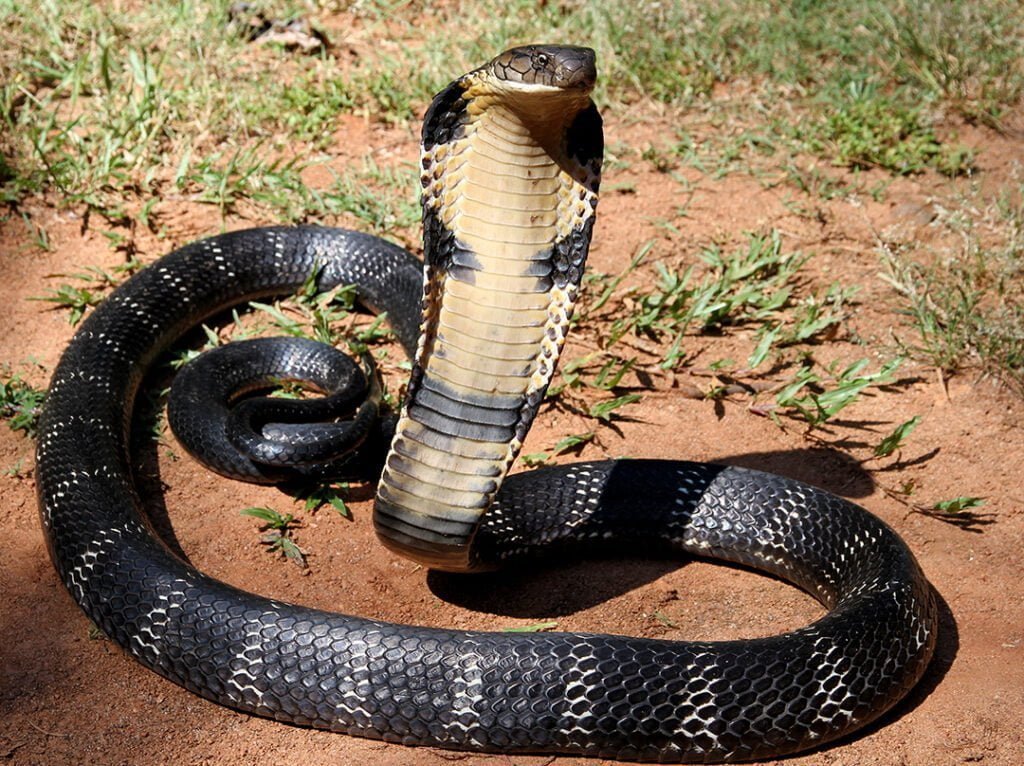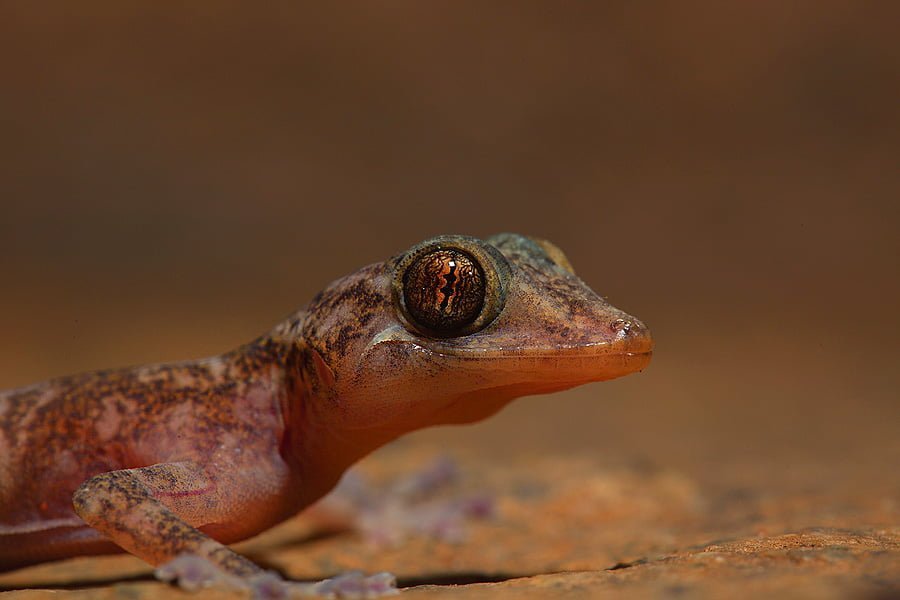King cobra Facts, FAQs, Behaviour, Habitat, Conservation and More

King cobra Facts | Description | Distribution and Habitat | Conservation | Behaviour and Ecology | Interaction with Human | Cultural | Interesting facts | frequently asked questions about King cobra
The Amphibian King cobra, also known as Ophiophagus Hannah, is a magnificent and fearsome species of snake that has captured the imagination of people for centuries. With its distinctive hood and deadly venom, the King cobra is both a symbol of power and a formidable predator. This awe-inspiring creature is renowned for its incredible size and agility, as well as its ability to adapt to a wide range of environments. From the dense jungles of Southeast Asia to the arid deserts of India, the King cobra reigns supreme as one of the most fascinating and enigmatic creatures of the animal kingdom. In this article, we’ll take a closer look at the Amphibian King cobra and explore its unique characteristics, behavior, and habitat. So, get ready to slither into the fascinating world of this iconic snake!
Taxonomy of King cobra
| Domain | Kingdom | Phylum | Class | Order | Family | Genus | Species |
|---|---|---|---|---|---|---|---|
| Eukarya | Animalia | Chordata | Reptilia | Squamata | Elapidae | Ophiophagus | Hannah |
Morphology of King cobra
| Body Part | Description |
|---|---|
| Head | Large, flattened, distinct from neck, with distinctive hood when threatened |
| Eyes | Large, round, with vertical pupils |
| Teeth | Long, hollow fangs that fold against the roof of the mouth when not in use |
| Body | Cylindrical, elongated, with smooth scales |
| Length | Can reach up to 18 feet (5.5 meters) in length |
| Weight | Can weigh up to 20 pounds (9 kilograms) |
| Coloration | Olive green, brown, or black with lighter bands on the body; cream or yellow on the belly |

Description of King cobra
- The King Cobra, or Ophiophagus hannah, is a venomous reptile that belongs to the family Elapidae.
- It is one of the longest venomous snakes in the world, reaching lengths of up to 18 feet (5.5 meters).
- The head of the King Cobra is distinct from the neck and is large and flattened, with a distinctive hood that it can expand when threatened.
- The eyes of the King Cobra are large and round, with vertical pupils that give it excellent depth perception.
- The body of the King Cobra is cylindrical and elongated, with smooth scales that are usually olive green, brown, or black with lighter bands on the body and cream or yellow on the belly.
- The King Cobra has long, hollow fangs that fold against the roof of the mouth when not in use, and it can inject a large amount of venom in a single bite.
- It is found in forests and other habitats throughout Southeast Asia and parts of South Asia, and is known for its ability to adapt to a wide range of environments.
- The King Cobra is a solitary and aggressive predator that primarily feeds on other snakes and small mammals.
- It is an important species in many cultures and is revered for its power, grace, and deadly reputation.
Distribution and habitat of King cobra
- The King Cobra is found in forests and other habitats throughout Southeast Asia and parts of South Asia.
- Its range includes countries such as India, China, Bhutan, Nepal, Bangladesh, Myanmar, Thailand, Cambodia, Laos, Vietnam, Malaysia, Indonesia, and the Philippines.
- The King Cobra prefers dense, humid forests, but can also be found in grasslands, scrublands, and even urban areas.
- It is known for its ability to adapt to a wide range of environments, including agricultural areas and human settlements.
- In some areas, the King Cobra is considered to be an important predator that helps to control the populations of rodents and other small mammals.
- However, habitat loss and human persecution are major threats to the survival of the King Cobra, and it is considered to be a vulnerable species by the International Union for Conservation of Nature (IUCN).
Behaviour and Ecology of King cobra
- The King Cobra is a solitary and diurnal predator that feeds primarily on other snakes and small mammals.
- It has a highly developed sense of smell and vision, which helps it to locate prey and avoid predators.
- The King Cobra is a skilled hunter and is known for its intelligence and adaptability.
- It uses venom to subdue its prey, which it injects through its long, hollow fangs.
- The venom of the King Cobra is extremely potent and can cause paralysis, respiratory failure, and even death in humans.
- Despite its fearsome reputation, the King Cobra is generally not aggressive towards humans and will usually only attack if it feels threatened or cornered.
- When threatened, the King Cobra will raise its head and expand its hood in an attempt to intimidate its predator or prey.
- The King Cobra is oviparous and lays between 20 and 40 eggs at a time, which are incubated for approximately 2 months before hatching.
- Juvenile King Cobras are highly vulnerable to predation and may fall victim to larger snakes and birds of prey.
- The King Cobra plays an important role in the ecology of its habitat, helping to control the populations of rodents and other small mammals.
- However, habitat loss and human persecution are major threats to the survival of the King Cobra, and it is considered to be a vulnerable species by the International Union for Conservation of Nature (IUCN).
Conservation of King cobra
- The King Cobra is listed as a vulnerable species by the International Union for Conservation of Nature (IUCN) due to habitat loss, hunting, and collection for the illegal wildlife trade.
- Habitat loss is a major threat to the King Cobra as forests and other natural habitats are cleared for agricultural and urban development.
- The King Cobra is also hunted for its skin, which is used to make leather products, and for its meat, which is considered a delicacy in some cultures.
- The illegal wildlife trade is another major threat to the survival of the King Cobra, with individuals being captured and sold as exotic pets or for use in traditional medicine.
- Conservation efforts for the King Cobra include the protection of its natural habitat, the enforcement of laws to prevent hunting and the illegal wildlife trade, and the education of local communities about the importance of preserving this iconic species.
- Research into the ecology and behavior of the King Cobra is also important for developing effective conservation strategies.
- Zoos and other captive breeding programs can play a role in the conservation of the King Cobra by providing a safe environment for breeding and reintroduction into the wild.
- The conservation of the King Cobra is not only important for the survival of this iconic species, but also for the health of its ecosystem, as it plays an important role in controlling the populations of rodents and other small mammals.
Interaction with Human of King cobra
- The King Cobra has a fearsome reputation and is often viewed as a dangerous and aggressive animal by humans.
- However, the King Cobra is generally not aggressive towards humans and will usually only attack if it feels threatened or cornered.
- Most human fatalities from King Cobra bites occur when humans attempt to handle or kill the snake.
- The venom of the King Cobra is extremely potent and can cause paralysis, respiratory failure, and even death in humans.
- In some parts of its range, the King Cobra is hunted for its skin, which is used to make leather products, and for its meat, which is considered a delicacy in some cultures.
- The illegal wildlife trade is also a major threat to the King Cobra, with individuals being captured and sold as exotic pets or for use in traditional medicine.
- Education and awareness campaigns can help to reduce human-wildlife conflict and promote the conservation of the King Cobra and its habitat.
- The King Cobra plays an important role in the ecology of its habitat, helping to control the populations of rodents and other small mammals, and its conservation is important for the health of its ecosystem.
- Encounters with the King Cobra in the wild should be avoided, and individuals who encounter a King Cobra should give the animal a wide berth and seek the assistance of trained professionals if necessary.
Cultural and Historical Significance of King cobra
- The King Cobra has a long history of cultural significance in many parts of Asia, where it is revered as a symbol of power, strength, and divinity.
- In Hindu mythology, the King Cobra is associated with Lord Shiva, one of the principal deities of Hinduism, who is often depicted with a coiled King Cobra around his neck.
- The King Cobra is also considered a sacred animal in some Buddhist and Taoist traditions, and is believed to possess spiritual powers and offer protection against evil spirits.
- In some cultures, the venom of the King Cobra is used in traditional medicine to treat a variety of ailments, although this practice is highly controversial and can have serious health risks.
- The King Cobra has also been featured in many works of art and literature, including poetry, novels, and films, where it is often depicted as a symbol of danger, power, and mystery.
- The King Cobra has played an important role in the history of herpetology, the study of reptiles and amphibians, as it was one of the first snakes to be studied in detail by Western scientists.
- The venom of the King Cobra has been the subject of extensive research and has led to the development of important medical treatments, including antivenom for snake bites.
- The conservation of the King Cobra is important not only for its ecological significance, but also for its cultural and historical significance, as it represents an important part of the cultural heritage of many countries in Asia.
Explanatory Notes for King cobra
- The King Cobra is a species of venomous snake that is found primarily in Southeast Asia and parts of India.
- It is the longest venomous snake in the world, with some individuals reaching lengths of up to 18 feet (5.5 meters).
- The King Cobra is easily recognized by its distinctive hood, which it flares when threatened or aggressive.
- It is an apex predator in its habitat, feeding primarily on other snakes, as well as lizards, rodents, and birds.
- The venom of the King Cobra is highly potent and can cause paralysis, respiratory failure, and even death in humans if not treated promptly.
- Despite its fearsome reputation, the King Cobra is generally not aggressive towards humans and will usually only attack if it feels threatened or cornered.
- The King Cobra is a solitary animal and is most active during the daytime, although it may also be active at night in areas with high levels of human activity.
- The King Cobra is listed as a species of least concern by the International Union for Conservation of Nature (IUCN), although it is threatened by habitat loss, hunting, and the illegal wildlife trade.
- The conservation of the King Cobra is important not only for its ecological significance, but also for its cultural and historical significance, as it represents an important part of the cultural heritage of many countries in Asia.
- Encounters with the King Cobra in the wild should be avoided, and individuals who encounter a King Cobra should give the animal a wide berth and seek the assistance of trained professionals if necessary.
Interesting facts about King cobra
Here are 10 interesting facts about the King Cobra:
- The King Cobra is the longest venomous snake in the world, with some individuals reaching lengths of up to 18 feet (5.5 meters).
- The King Cobra is not a true cobra, but rather belongs to its own genus called Ophiophagus, which means “snake-eater”.
- The King Cobra is an apex predator in its habitat and feeds primarily on other snakes, as well as lizards, rodents, and birds.
- The venom of the King Cobra is highly potent and can cause paralysis, respiratory failure, and even death in humans if not treated promptly.
- The King Cobra is easily recognized by its distinctive hood, which it flares when threatened or aggressive.
- The King Cobra is a solitary animal and is most active during the daytime, although it may also be active at night in areas with high levels of human activity.
- The King Cobra can inject a large amount of venom in a single bite, and can kill a human in as little as 30 minutes.
- The King Cobra has been featured in many works of art and literature, including poetry, novels, and films, where it is often depicted as a symbol of danger, power, and mystery.
- The King Cobra is an important part of the cultural heritage of many countries in Asia, where it is revered as a symbol of power, strength, and divinity.
- The conservation of the King Cobra is important not only for its ecological significance, but also for its cultural and historical significance, as it represents an important part of the cultural heritage of many countries in Asia.
General queries or frequently asked questions about King cobra
What is a King Cobra?
The King Cobra is a species of venomous snake that is found primarily in Southeast Asia and parts of India. It is the longest venomous snake in the world, with some individuals reaching lengths of up to 18 feet (5.5 meters).
How does a King Cobra defend itself?
The King Cobra is easily recognized by its distinctive hood, which it flares when threatened or aggressive. It may also hiss loudly and make striking motions to ward off potential threats.
What is the diet of a King Cobra?
The King Cobra is an apex predator in its habitat and feeds primarily on other snakes, as well as lizards, rodents, and birds.
Is the King Cobra dangerous to humans?
Yes, the venom of the King Cobra is highly potent and can cause paralysis, respiratory failure, and even death in humans if not treated promptly. However, the King Cobra is generally not aggressive towards humans and will usually only attack if it feels threatened or cornered.
Where does the King Cobra live?
The King Cobra is found primarily in Southeast Asia and parts of India, including Bangladesh, Bhutan, Cambodia, China, India, Indonesia, Laos, Malaysia, Myanmar, Nepal, the Philippines, Thailand, and Vietnam.
Is the King Cobra an endangered species?
The King Cobra is listed as a species of least concern by the International Union for Conservation of Nature (IUCN), although it is threatened by habitat loss, hunting, and the illegal wildlife trade.
What is the cultural significance of the King Cobra?
The King Cobra is an important part of the cultural heritage of many countries in Asia, where it is revered as a symbol of power, strength, and divinity. It has also been featured in many works of art and literature, including poetry, novels, and films.
How can people help conserve the King Cobra?
The conservation of the King Cobra is important not only for its ecological significance, but also for its cultural and historical significance. People can help conserve the King Cobra by supporting conservation efforts and by avoiding practices that contribute to habitat loss, hunting, and the illegal wildlife trade.
Conclusion
In conclusion, the King Cobra is a fascinating and highly distinctive species of snake that is known for its size, power, and venomous bite. Despite its fearsome reputation, the King Cobra is generally not aggressive towards humans and will usually only attack if it feels threatened or cornered.
The King Cobra is an important part of the cultural heritage of many countries in Asia, where it is revered as a symbol of power, strength, and divinity. However, the King Cobra is also threatened by habitat loss, hunting, and the illegal wildlife trade, which highlights the need for conservation efforts to protect this iconic species.
Overall, the King Cobra is an incredible animal that has captured the imagination of people around the world. Its unique features, fascinating behavior, and cultural significance make it a truly remarkable species that is deserving of our admiration and protection.












